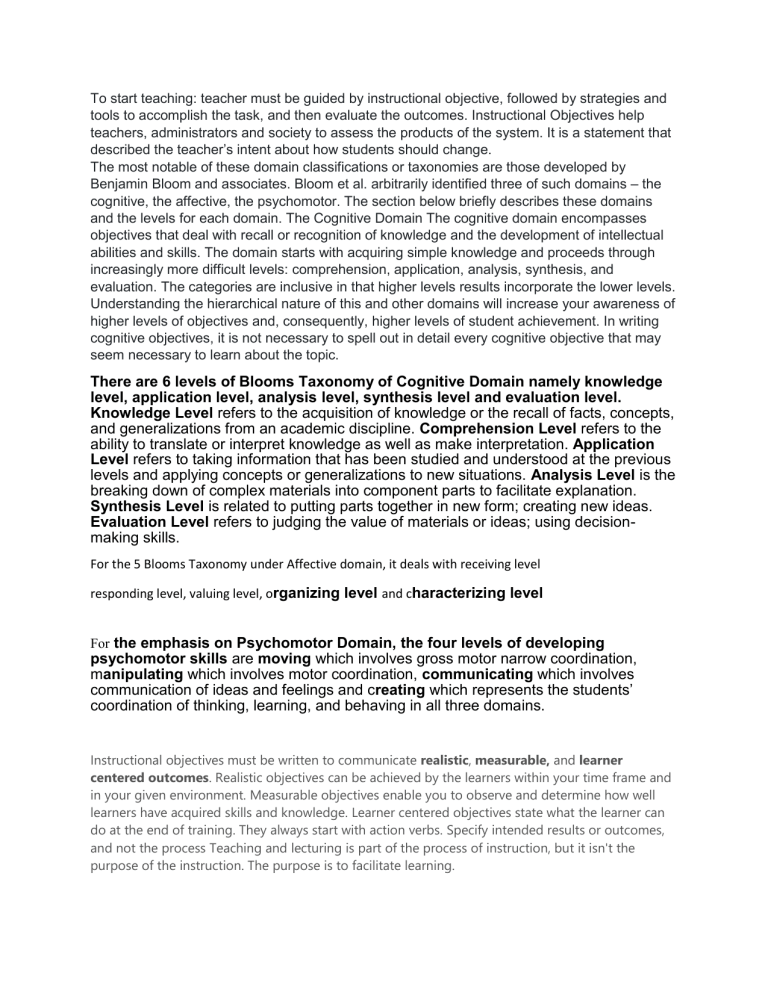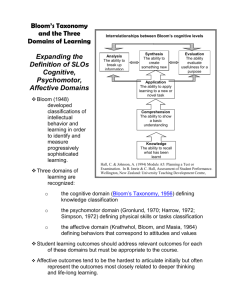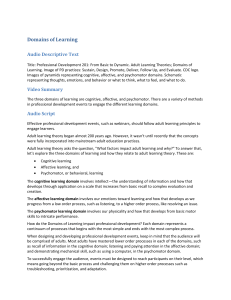
To start teaching: teacher must be guided by instructional objective, followed by strategies and tools to accomplish the task, and then evaluate the outcomes. Instructional Objectives help teachers, administrators and society to assess the products of the system. It is a statement that described the teacher’s intent about how students should change. The most notable of these domain classifications or taxonomies are those developed by Benjamin Bloom and associates. Bloom et al. arbitrarily identified three of such domains – the cognitive, the affective, the psychomotor. The section below briefly describes these domains and the levels for each domain. The Cognitive Domain The cognitive domain encompasses objectives that deal with recall or recognition of knowledge and the development of intellectual abilities and skills. The domain starts with acquiring simple knowledge and proceeds through increasingly more difficult levels: comprehension, application, analysis, synthesis, and evaluation. The categories are inclusive in that higher levels results incorporate the lower levels. Understanding the hierarchical nature of this and other domains will increase your awareness of higher levels of objectives and, consequently, higher levels of student achievement. In writing cognitive objectives, it is not necessary to spell out in detail every cognitive objective that may seem necessary to learn about the topic. There are 6 levels of Blooms Taxonomy of Cognitive Domain namely knowledge level, application level, analysis level, synthesis level and evaluation level. Knowledge Level refers to the acquisition of knowledge or the recall of facts, concepts, and generalizations from an academic discipline. Comprehension Level refers to the ability to translate or interpret knowledge as well as make interpretation. Application Level refers to taking information that has been studied and understood at the previous levels and applying concepts or generalizations to new situations. Analysis Level is the breaking down of complex materials into component parts to facilitate explanation. Synthesis Level is related to putting parts together in new form; creating new ideas. Evaluation Level refers to judging the value of materials or ideas; using decisionmaking skills. For the 5 Blooms Taxonomy under Affective domain, it deals with receiving level responding level, valuing level, organizing level and characterizing level For the emphasis on Psychomotor Domain, the four levels of developing psychomotor skills are moving which involves gross motor narrow coordination, manipulating which involves motor coordination, communicating which involves communication of ideas and feelings and creating which represents the students’ coordination of thinking, learning, and behaving in all three domains. Instructional objectives must be written to communicate realistic, measurable, and learner centered outcomes. Realistic objectives can be achieved by the learners within your time frame and in your given environment. Measurable objectives enable you to observe and determine how well learners have acquired skills and knowledge. Learner centered objectives state what the learner can do at the end of training. They always start with action verbs. Specify intended results or outcomes, and not the process Teaching and lecturing is part of the process of instruction, but it isn't the purpose of the instruction. The purpose is to facilitate learning.


